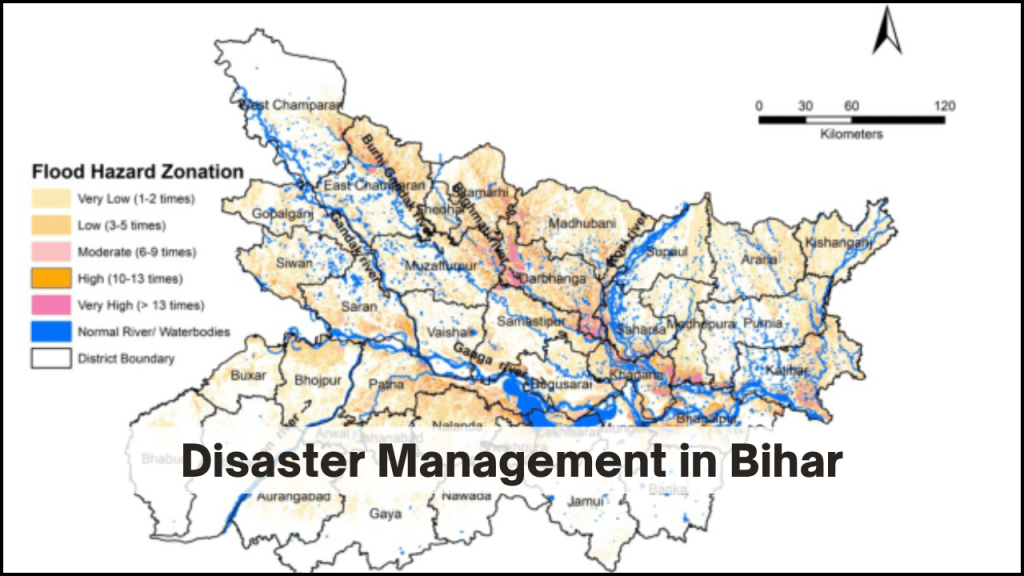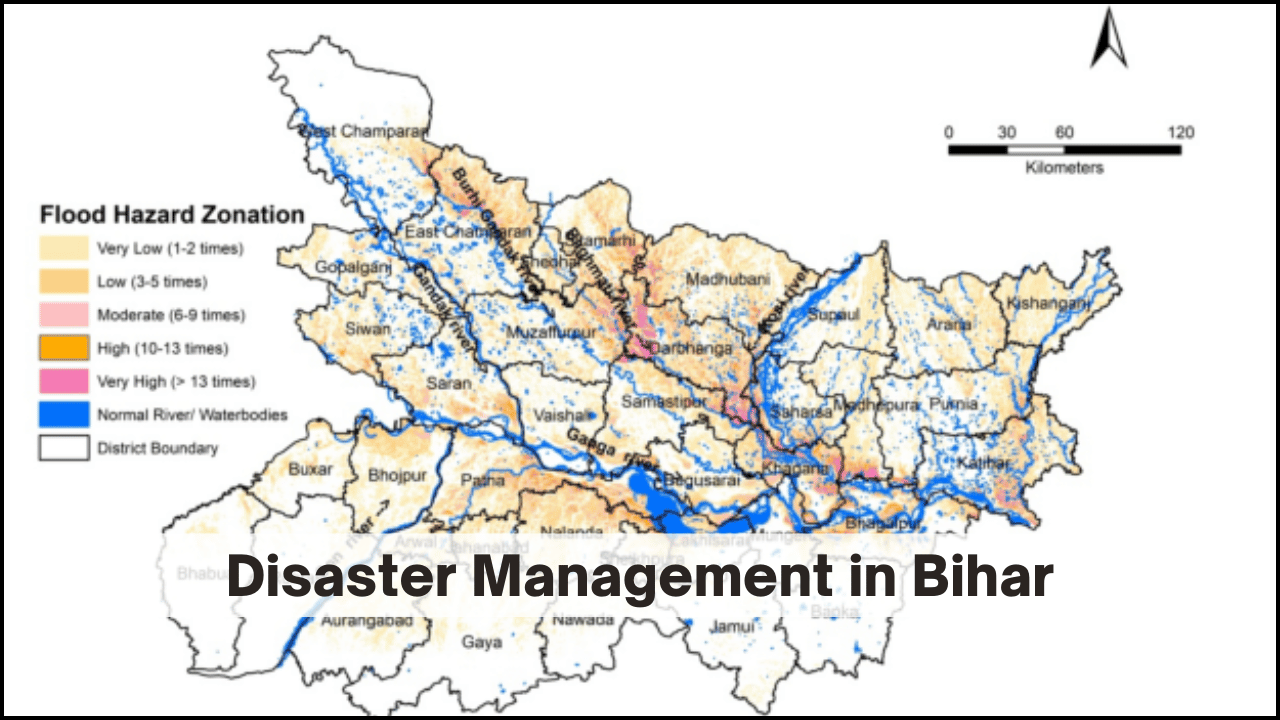
Bihar, one of the most disaster-prone states in India, faces frequent natural and human-induced hazards that severely impact lives, livelihoods, and infrastructure. Its unique geographical position, demography, and socio-economic vulnerabilities make it highly susceptible to disasters such as floods, earthquakes, droughts, cyclones, and fire outbreaks. Effective disaster management in Bihar is essential for reducing risks, minimizing losses, and ensuring rapid response and recovery.
Hazard Profile of Bihar
Bihar’s disaster profile is characterized by multiple hazards, both natural and man-made. The state witnesses recurrent floods, droughts, and earthquakes, which disrupt normal life and hinder economic growth. Below is an overview of the key hazards affecting Bihar:
1. Floods
Bihar experiences some of the most devastating floods in India. Around 73% of its total geographical area is vulnerable to flooding. Major rivers such as the Ganga, Koshi, Gandak, Bagmati, and Mahananda frequently overflow, affecting districts like Supaul, Darbhanga, Muzaffarpur, Sitamarhi, and Purnia. Factors contributing to floods include excessive rainfall in the catchment areas, embankment breaches, and poor drainage systems. The 2008 Koshi floods were one of the worst in Bihar’s history, displacing millions and causing significant damage.
2. Earthquakes
Bihar falls under seismic zones IV and V, making it highly prone to earthquakes. The Bihar-Nepal seismic belt poses a significant risk, with major past earthquakes such as the 1934 Bihar-Nepal earthquake (8.4 magnitude) causing massive destruction. The dense population and unplanned urban settlements increase the vulnerability to seismic hazards.
3. Droughts
Drought is another recurring hazard in Bihar, particularly in the southern and central regions, including districts like Gaya, Nawada, Aurangabad, and Jehanabad. Insufficient monsoon rainfall affects agriculture, which is the primary livelihood source for the majority of the population. With nearly 33% of Bihar’s area being drought-prone, water scarcity and crop failure are major concerns.
4. Cyclones & Storms
Bihar occasionally faces cyclonic storms, particularly those originating in the Bay of Bengal. These storms bring heavy rainfall, strong winds, and infrastructural damage. The 2019 Cyclone Fani affected several districts in Bihar, causing destruction of property and loss of life.
5. Fire Accidents
Fire outbreaks, particularly in rural Bihar, are common during the summer months. Thatched-roof houses, dry conditions, and the use of traditional cooking methods make villages highly liable to fire incidents. Urban areas also experience fire hazards due to electrical faults, industrial accidents, and improper safety measures.
Disaster Management Framework in Bihar
To mitigate and manage disasters effectively, Bihar has implemented a multi-tier disaster management approach, involving government bodies, local authorities, and community participation.
1. Institutional Framework
- Bihar State Disaster Management Authority (BSDMA): Formed under the Disaster Management Act, 2005, BSDMA plays a crucial role in planning, mitigation, and preparedness strategies.
- District Disaster Management Authorities (DDMAs): Every district in Bihar has a DDMA responsible for executing disaster management plans and coordinating relief efforts.
- State Emergency Operation Center (SEOC): This serves as the central control room for disaster monitoring, early warning dissemination, and response coordination.
2. Flood Management Strategies
- Construction & Maintenance of Embankments: Bihar has over 3,700 km of embankments to control river flooding.
- Flood Forecasting & Early Warning Systems: The state government collaborates with the Central Water Commission (CWC) to monitor river levels and issue timely warnings.
- Community-Based Flood Preparedness: Villagers in flood-prone areas receive training in evacuation, rescue, and first aid.
3. Earthquake Risk Reduction
- Seismic-Resistant Infrastructure: The Bihar Building By-laws mandate earthquake-resistant construction for all public and private buildings.
- School Safety Program: Schools in seismic zones conduct regular safety drills and structural audits to ensure preparedness.
- Public Awareness Campaigns: Programs educating citizens on earthquake safety measures are conducted through workshops and media outreach.
4. Drought Mitigation Measures
- Water Conservation & Irrigation Projects: Initiatives like the Jal-Jeevan-Hariyali Abhiyan aim to improve groundwater levels and promote rainwater harvesting.
- Crop Diversification & Drought-Resistant Farming: Farmers are encouraged to grow less water-intensive crops and adopt modern agricultural techniques.
- Subsidized Crop Insurance: The Pradhan Mantri Fasal Bima Yojana (PMFBY) provides financial security against crop failures due to droughts.
5. Fire Prevention & Response
- Improved Fire Safety Regulations: Mandatory fire safety checks for commercial and residential buildings.
- Community Fire Brigades: Rural fire prevention committees have been set up to raise awareness and provide immediate response.
- Strengthening Fire Services: The state has expanded its fire stations and equipped them with modern firefighting equipment.
Challenges in Disaster Management
Despite these measures, Bihar faces several challenges in effective disaster management:
- Weak Infrastructure: Poor roads, weak embankments, and lack of adaptable housing increase disaster vulnerability.
- Delayed Response & Relief Efforts: Limited resources and bureaucratic delays often slow down relief operations.
- Lack of Public Awareness: Many rural communities remain unaware of disaster preparedness strategies.
- Climate Change Impact: Changing rainfall patterns and increasing frequency of extreme weather events complicate disaster management efforts.
